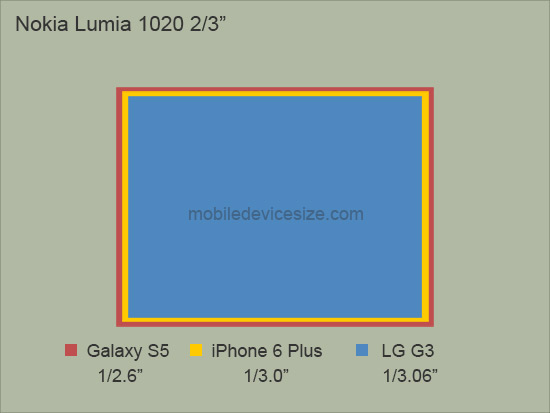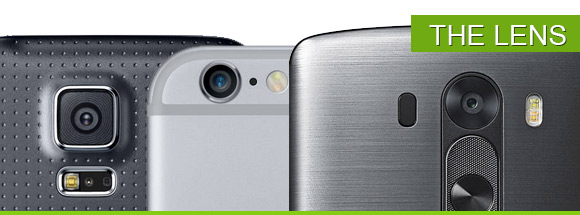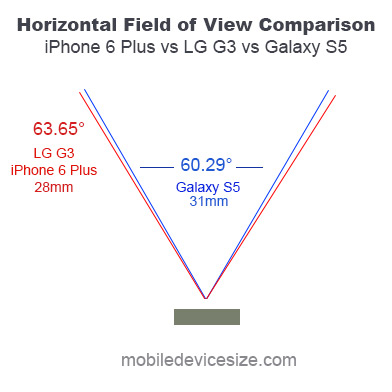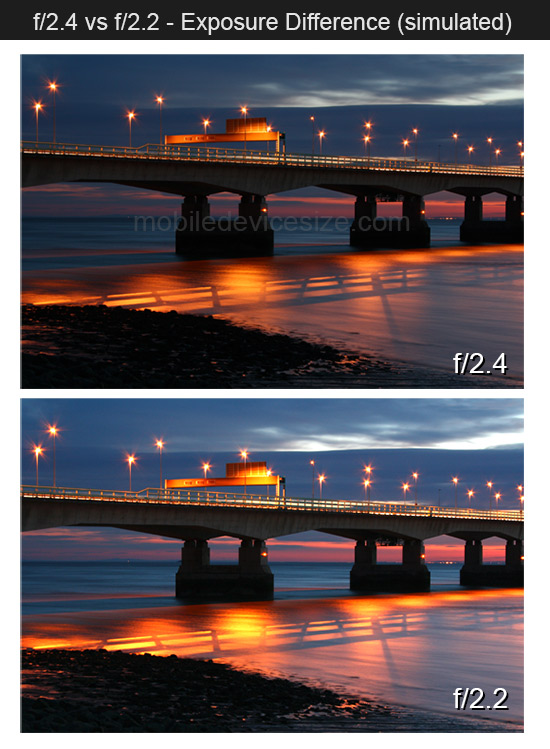
In this article I’ll compare the iPhone 6 Plus rear-facing (main) camera versus the rear cameras of the Samsung Galaxy S5 and LG G3. All the three are new generation mobile phones, and each one has taken the camera capabilities a step forward. As mobile photography continues to evolve, it’s interesting to see how these three high-end smartphones stacks against each others in the photo category.
In each section we’ll cover different common features for each camera, to give you a good view of the differences between them and learn more about the cons and pros of each one.
Sensor Size
We’ll start with the iPhone 6 Plus, LG G3 and Galaxy S5 sensor size comparison. The sensor size (pixel size to be more correct) play a significant role in the camera image quality performance. In general, a larger sensor and one with larger pixels (there is an option for a larger sensor to have smaller pixels depends on the active pixels/resolution) have several advantages over a smaller sensor with smaller pixels. Larger photodiodes have the ability to collect more light photons, which leads for each pixel to contain more color data for each pixel in the image, leading to a higher dynamic range, better detailed image (for a given resolution) and better low-light performance in general.
Furthermore, for a given same equivalent lens aperture and focal length, a larger sensor allows more prominent defocused background and therefore the ability to better separate the subject from the background. With small sensors this ability is much less prominent, and you’ll need to shoot up close in order to achieve a well defocused background. The thing is that smaller sensors have higher crop factor ratio, therefore an equivalent of, let’s say 28mm, the focal length of the lens is smaller on a smaller sensor, and the focal length used to get the same equivalent focal length is smaller. This also true to the aperture, although the aperture in terms of exposure is the same regardless of the sensor size.
Let’s take a look at the iPhone 6, LG G3 and Samsung Galaxy S5 sensor specs. The following specs refer to the main camera only, the one on the back size of the phone.
[table id=182 /]
Looking at the specs, we can see that each of the main cameras for each phone has a different sensor size, with the Galaxy S5 having the biggest sensor among the three, iPhone 6 Plus second and LG G3 with the smallest one. The differences are not big, and certainly the sensors of all three are much smaller than the Nokia Lumia 1020 2/3″ sensor (see image below) and certainly smaller than the 1/1.2″ (10.67×8.00mm) sensor of the Nokia 808 PureView. That being said, the sensor technology and image processing also plays a significant role here.

You can see in the above sensor size comparison illustration, that the S5 has the largest sensor of the three, but it’s a small difference. You might expect the Lumia 1020 or the 808 PureView to put the iPhone 6 Plus to shame, but according to DxOMark Mobile tests, the Apple iPhone 6 Plus has taken the top spot with 82 total score, whether the S5 is pushed to the third place with 79 total score and Lumia 1020 is at the 10th position with a total score of 74. Of course there other other things that we need to take into consideration here, like the lens and sensor properties. Having said that, the sensor size itself, doesn’t directly mean better image quality.
We can see that the iPhone 6 Plus has the lowest resolution, which leads to a much larger pixels compare to the LG G3 and Galaxy S5. Both the LG G3 and the S5 have around the same pixel size of 1.12 microns, although their sensor sizes are different. That because each one has different resolution. In this case, we can expect the iPhone 6 Plus to outperform the others in low-light, and according to DxOMark, this is indeed the case.
The LG G3 has 67.5% more pixels than the iPhone 6+ and only 22% more than the S5. Some people prefer shooting with a camera with higher resolution, because that gives them better cropping freedom in photo editing software or when editing their image using the built-in apps. That said, I think that Apple is doing great maintaining the relative low resolution, in favor of better image quality and low-light performance, a compromise that many people learn to appreciate. Most people won’t take advantage of that high resolution and most just want to share photos on Facebook, Twitter or Instagram — for that, even 2MP will suffice, don’t you think?
All three cameras take advantage of the backside-illuminated technology, where the data transfer wires are at the back instead of the front as in front-illuminated sensors. This technology improved the S/N ratio and the photo capture efficiency which can improve the low-light performance up to two times compared to FSI sensors.
The S5 uses a sensor technology called ISOCELL. With a unique BSI design with integrated barriers between the pixels that decrease crosstalk between pixels by up to 30%, the ISOCELL has 20% wider chief ray angle. The result is the ability to produce slimmer camera modules for slimmer smartphones and and increase the dynamic range and promote better looking image. The video below visually explains this technology.
http://www.youtube.com/watch?v=xP1QR5pFtrQ
Both the Galaxy S5 and iPhone 6 Plus have on-sensor phase-detection pixels, and we’ll talk about those in the next section when we look into the AF system of each camera.
AF Performance
The camera AF performance plays a significant role for many photographers. Mobile casual mobile phone owners probably weren’t aware of what an AF system is, but as the AF system technology is being advertised and explained by phone manufacturers more people are aware of its importance. When I say “AF performance” I refer to how fast it takes for the camera to focus on a subject when the focus is set by default to infinity. The faster the time it takes to focus on a close object, the better the AF performance in general.
Of course there are many things to measure here, including subject tracking AF performance, Face detection AF performance and so on. Each camera uses its own AF technologies in order to improve the Autofocus speed and accuracy when shooting stills and when recording movie clips.
Before we jump deeper and talk about those differences, lets first take a look at the specs.
[table id=183 /]
We can see that the Samsung Galaxy S5 and Apple iPhone 6 Plus, both are utilizing the same AF technologies, a Hybrid AF system that takes advantage of both contrast-detect AF and phase-detect AF technologies. The LG G3 is the first mobile phone that use the “laser autofocus” system which was researched for the LG Roboking robotic vacuum cleaner, but eventually also found itself in the LG G3. What this system does is using Infrared light beam to gain depth and position information of objects in the scene at the area of focus of which you want to focus. The light than bounces back to the camera and it can measure the distance and position of that object, considerably reducing seeking time. In conjugation with the contrast-detect AF system, it promotes faster AF performance, as the camera don’t need to always “guess” and run contrast comparisons that lead to “hunting” (lens moves forward and backward to find the exact focus, as with contrast-detect systems).
So how the amazing LG G3 Autofocus performance compared to the Galaxy S5. How fast is the Laser Autofocus system vs phase-detection?
Samsung put both the the test, and here’s the results!
As we can see from the above video, the LG G3 focused considerably faster than the S5, but the s5 performed faster than the S4. In a test done by Jose here, we can see that the iPhone 6 was able to out perform the LG G3. Anandtech.com has tested the camera focus latency for the LG G3 and S 5 and and both were very close, with the LG G3 having a 34 ms advanced. tomsguide.com conclude that the LG G3 was slightly faster than the S5, especially in low-light.
So from all that I’ve read, the LG G3’s Laser technology should give it a slight advantage over the iPhone 6 Plus and Galaxy S5 phase-detection, which for me camera as a good surprise, considering the fact that most of the professional cameras on the market use phase-detection. Panasonic is also one of the companies that used a technology called DFD to take advantage of depth info to support faster contrast-detect AF performance. It’s seems that this technology can perform on par or even better in some situations than phase-detection from what I can tell. All in all, not a big difference, but certainly you can expect excellent AF performance from the LG G3, although it doesn’t employ on-sensor phase-detect pixels.
The Camera Lens

The camera lens plays a significant role in the image quality, camera’s creative options, image distortions and aberration and low-light performance. Most of the mobile phone cameras on the market use prime lenses, which have a 1x optical zoom (no zoom) or in other words, a fixed focal length. These type of lenses are known to perform very well optically compared to zoom lenses, but they pose some limitations as the photographer can’t zoom in on the subject, and therefore need to take a few steps to fill in the subject in the frame. So forget about shooting a close up of a lion in the zoo, but we all got used to it, haven’t we?
Let’s take a look at iPhone 6 Plus, LG G3 and Samsung Galaxy S5 lens specs first.
[table id=184 /]
source: esato.com
Looking at the iPhone 6 Plus, LG G3 and Samsung Galaxy S5 lens specs, we can see that there are some differences to talk about. First of all, both the iPhone 6 Plus and LGG3 have a wider angle lens. Lets take a look how it converts to angle of view, how much wider is 29mm compared to 31mm.
- 29mm equivalent focal length translates to:
Horizontal angle of view: 63.65°
Vertical angle of view: 44.96° - 31mm equivalent focal length translates to:
Horizontal angle of view: 60.29°
Vertical angle of view: 42.32°

As you can see from the above illustration, the iPhone 6 Plus and LG G3 have a wider shooting angle, which is wider, allowing you to capture more of the surrounding. This is better for group shots, landscapes, interiors and everywhere where a wide angle can help you get more info into the frame as required a particular shot or video footage.
Another important specs that is directly related to the low-light performance of the camera phone is the maximum aperture. The aperture is the hole from which the light passes though towards the image sensor. The larger that hole, the more light that can pass through. The LG G3 has the (relatively) slowest aperture among the three. The difference between f/2.0 and f/2.4 is 1/3 (rounded up) of a stop or 0.2511 stops to be precise. Each stop translates to two times more light transmission efficiency, which leads to that f/2.0 aperture gives 1.19x times more light compared to f/2.4.

Both the Samsung Galaxy S5 and iPhone 6 Plus win against the LG G3 in terms of low-light performance due to the faster aperture and considering the fact that both the LG G3 and the SGS5 have the same pixel size. The iPhone 6 Plus improved upon the iPhone 5S in the low-light department and performed even much better than the Galaxy S5, which we can probably credit to its larger pixels. So if you are after a phone with the best low-light performance, the iPhone 6 Plus easily takes the crown here, with the S5 second and the G3 at the last position. You can check out the sample image on phonearena.com, where you can clearly see the difference between the Apple iPhone 6 and Samsung Galaxy S5 photos (scroll right to see the low-light pictures).
Image Stabilization
The iPhone 6 Plus is Apple’s first iPhone to have an optical image stabilization, rather than only digital stabilization which is done on the software side. The LG G3 and the iPhone 6 Plus therefore have an advantage compared to the S5 for video recording and when shooting stills.
Check the video below made by TechSource testing the G3 and G5 side by side, including a stabilization test at 4:35 min. Bot cameras suffer from stabilization issues in some degree or another. I was much more impressed with the iPhone 6 Plus stabilization as you can see in the video below from TechnoBuffalo.
Looks much much better, very smooth and I don’t get a headache while watching it. So as for what I’ve seen so far, the iPhone 6 Plus with its Cinematic Video Stabilization takes the crown. The “Cinematic Video Stabilization” is an improved version of the digital stabilization of previous models, giving more stable view when shooting while walking, and it’s certainly not a gimmick and it works beautifully as you can see on many iPhone 6 Plus sample videos on YouTube. Things are going very well for the iPhone 6 Plus so far.
Video Performance
We already see some video samples taken with the cameras of the S5, G3 and the iPhone 6 Plus. Let’s look at the video specifications for the three devices.
[table id=185 /]
The LG G3 and the Samsung Galaxy S5 both have a maximum recording resolution of 4K, which is twice that of the iPhone 6 Plus. Many people expected Apple to put 4K in its next iPhone, but instead Apple has decided to just bump up the frame rate and introduce 1080p60 (progressive frames) option. A higher progressive frame rate allows more flexible editing in video editing software, like applying slow-motion to certain parts of the click with minimum impact on image quality, as well as creating smoother playback. It obviously leads to a larger file size.
Of course in order to enjoy those 4K videos to their fullest potential, you’ll need a 4K HDTV or computer display. Not everyone have one of those because they still are quite expensive. Still, the image quality is very impressive and the 720p240 is fun and engaging and can produce some very creative results.
The next video made by SlashGear demonstrates the image quality , slow-mo and time-lapse feature.
If you have a 4K display you can enjoy this Samsung Galaxy S5 4K UHD video in its fullest resolution resolvement power, and the details.. oh the details.
Now for a 4K LG G3 sample video.
Mind blowing, just breathtaking how beautiful and how details these footage are. You need to keep the phone stable as possible for all three phones in order to get a very stable video, as any tiny shake can cause a rolling shutter wobble effect, also known as jello effect. At the hand of an experience photographer, the results can be quite astonishing as you can see from the above video.
Some people might find it a bit disappointing that the iPhone 6 Plus lacks 4K videos recording and that Apple didn’t increase the sensor resolution, but I think that in the next iteration (iPhone 7, iPhone 7 Plus), we’ll see 4K recording. I don’t know if it can be enabled via software update, but I believe not.
Both the iPhone 6 Plus and LG G3 enjoy the optical stabilization, but I favor the iPhone 6 Plus for its improved digital stabilization, faster aperture and better low-light capability.
Now for a cool and something refreshing before we continue on… How about iPhone 6 Plus vs Liquid Nitrogen? — well, this is what RatedRR YouTube user has done. Poor iPhone 6 Plus, it doesn’t deserve such a treatment, but it was cool to watch anyways.
Other Features
Here are some other key features of the main camera for each device.
[table id=186 /]
The Samsung Galaxy S5 is probably the most fully reached when it comes to camera software features, which many are inherited from the S4. Samsung put a big effort to improve on the software side. Some features are indeed quite gimmicky, others quite useful. The apps that you download will eventually give you all that you need and be able to further extend of what the default camera software offers. What I liked about the iPhone 6 Plus more than the others is that it now features full control over the manual camera settings, including shutter speed, aperture and ISO. These settings are now available for developers to control using the Camera SDK with the new iOS 8 operating system.
Having the option to manually control the aperture, ISO and shutter speeds, open up a whole new world of creative options for amateur photographers and make it also a good learning tool. Now everyone will know what aperture, shutter speed and ISO is, and how those effect the final output. You can also try out the “Manual – Custom Exposure for your iPhone Camera” app (website shootmanual.co) that gives you full control over the shutter speed, ISO, White Balance, Focus and exposure compensation, even if you don’t have the iPhone 6, but it requires iOS 8 or later .
By exposing those camera adjustments to developer to control, Apple opened a door for many innovative and more useful camera apps.
Conclusion
The Apple iPhone 6 Plus improved where it should have been improved, and the results lead to improved image quality and better low-light performance for both stills and videos, that put it at the top position. leaving the Galaxy S5 and Sony Xperia Z3 behind. Looking at the sensor, lens and video specs, you can understand why so many people are excited about the iPhone 6 Plus camera. The LG G3 and Galaxy S5 has their cons and pros like the 6 Plus.
Most people are searching for a camera that is easy and fun to use, one that can take gorgeous pictures with lots of details and great colors. The image stabilization certainly helps to promote better looking and sharp image, even in low-light situations. Speaking of low-light performance, this is probably the iPhone 6 Plus strongest features, and I always happy to see Apple improving on that.
Most people won’t by a phone only for its camera performance, but some do. Even considering the whole package, the iPhone 6 Plus is a superb performer, it looks amazing and has a gorgeous display which makes every photos or video look amazing. If I had to choose a winner, I would give my top score to the iPhone 6 Plus.
I am interested to know what is your opinion now that you know some of the facts about those three mobile phone cameras. Which one do you prefer and why? — please share your opinion in the comment section below and share your opinion with us. Thanks for reading, and please don’t forget to share this comparison review if you find it useful.
Check out the Apple iPhone 6 Plus vs S5 and G3 size comparison here.